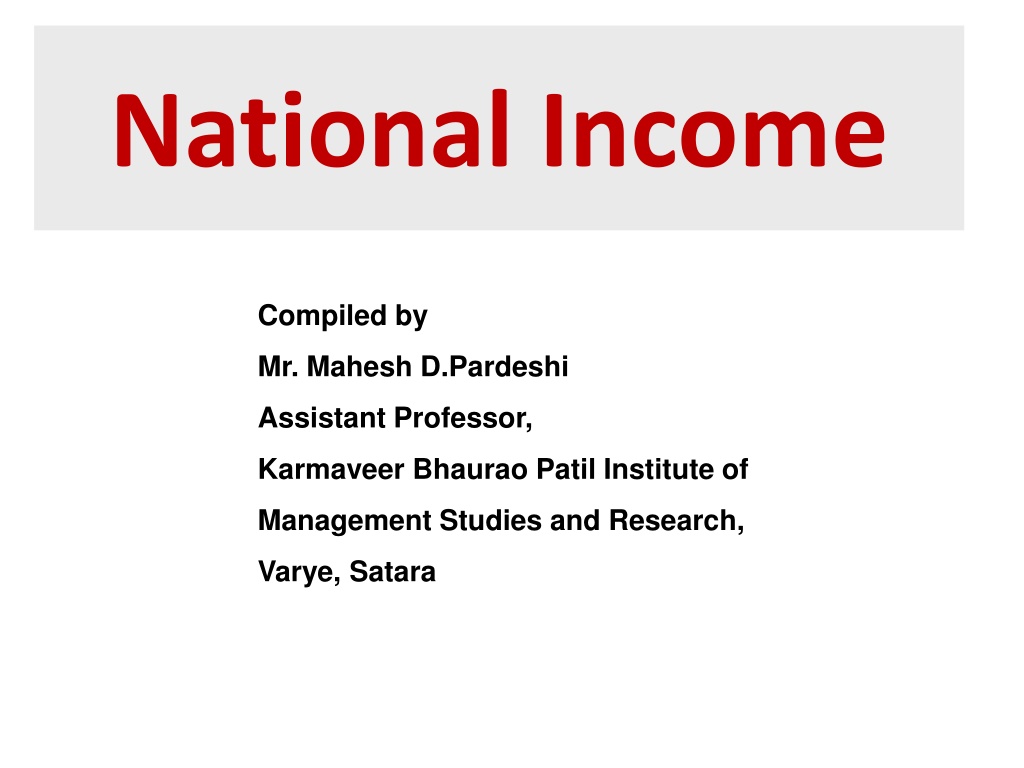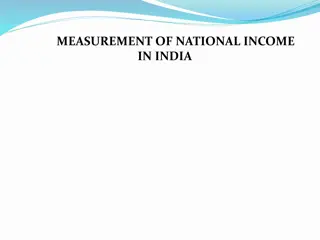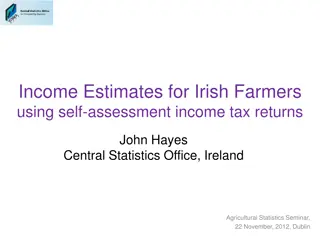Understanding National Income and Its Importance in Economics
National income is a crucial measure of the value of goods and services produced in an economy. It provides insights into economic growth, living standards, income distribution, and more. Concepts such as GDP, GNP, Personal Income, and Per Capita Income help in understanding the economic health of a country. By analyzing the circular flow of production, income, and expenditure, economists gain valuable information for making informed decisions.
Download Presentation

Please find below an Image/Link to download the presentation.
The content on the website is provided AS IS for your information and personal use only. It may not be sold, licensed, or shared on other websites without obtaining consent from the author. Download presentation by click this link. If you encounter any issues during the download, it is possible that the publisher has removed the file from their server.
E N D
Presentation Transcript
National Income Compiled by Mr. Mahesh D.Pardeshi Assistant Professor, Karmaveer Bhaurao Patil Institute of Management Studies and Research, Varye, Satara
What is National Income? National income measures the total value of goods and services produced within the economy over a period of time.
Why is national income important? Measuring the level and rate of growth of national income is important to economists when they are considering: Economic growth and where a country is in the business cycle Changes to average living standards of the population Looking at the distribution of national income (i.e. measuring income and wealth inequalities)
NATIONAL INCOME CONCEPTS Gross domestic product (GDP) is defined as "an aggregate measure of production equal to the sum of the gross values added of all resident institutional units engaged in production Gross national product (GNP) is the market value of all the productsand services produced in one year by labor and property supplied by the citizens of a country.
Personal Income (PI) Personal Income i s the total money income received by individuals and households of a country from all possible sources before direct taxes. Per Capita Income (PCI) Per Capita Income of a country is derived by dividing the national income of the country by the total population of a country.
National Income: Concept and Measurement Production of goods and service generates income and income give rise to demand for goods and service, demand give rise to expenditure, and expenditure give further rise to production of goods and service. there is a circular flow of production, income and expenditure. On the basis of these flows, national income can be analysed at 1. as a flow of goods and services 2. as a flow of incomes 3. as a flow of expenditure on goods and services.
A. Product Method (a) Final product approach The final product approach involves estimation of the market value of final goods and services produced in the economy in a given period.
Steps in Final Product Approach: (i) The market value of all final goods and service produced within the country gives the estimate of Gross Domestic Product at Market Price (GDP at MP) (ii) The addition of net factor income from abroad in GDP at MP gives Gross National Product at Market Price (GNP at MP). (iii) The deduction of depreciation from Gross National Product at market price (GNP at MP) MP provides Net National Product at market Price (NNP at MP). (iv) The deduction of net indirect taxes from NNP at MP give Net National Product at Factor Cost (NNP at FC)
Problem of Double Counting The calculation of national income through final product approach considers the market value of final goods and services. The value of intermediate goods is not included. If the value of intermediate goods are considered, it will involve the problem of double counting. Double counting means, consideration of certain item more than once which leads to over estimation of national income.
B. Income Method It is the sum of all income derived from providing the factors of production. It includes wages and salaries, rent, interest and profits within a country in a given year.
Steps in Income Method: Steps in Income Method: 1. Obtain Net Domestic Product at Factor cost (NDP at FC) by summing up factors payment paid in form of wages & salary, rent, interest and profit by all production units of all sectors in the country. 2. Add Net factor income from abroad in Net Domestic Product at Factor Cost to obtain Net National Product at Factor Cost (NNP at FC) or national income.
C. Expenditure Method Expenditure method measures national income as aggregate of all the final expenditure on gross domestic product in an economy during a year. This is the sum of expenditure made for final consumer goods and investment demand, and for net export. Therefore, the sum of total income (Y) equals to the sum of final expenditure incurred on consumption goods (C) and the sum of investment goods (I). Symbolically, Y = C + I.
Steps in Expenditure Method: Steps in Expenditure Method: 1. GDP at MP = Gross National Expenditure at Market Price (GNE at MP) which the sum of Final private consumption expenditure (C), Government final consumption expenditure (G), Gross domestic private investment (I) which includes gross fixed capital formation plus changes in stocks, and Net export or export minus import (X- M) 2. An addition of net factor income from abroad (NFIA) to GDP at MP provides Gross National Product at market price (GNP at MP).

























